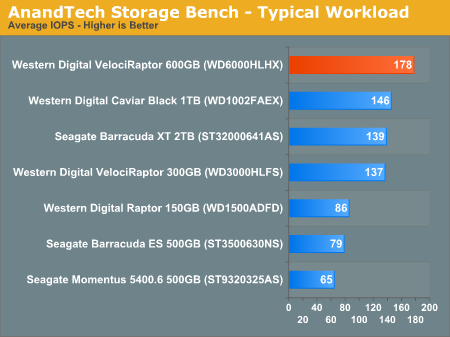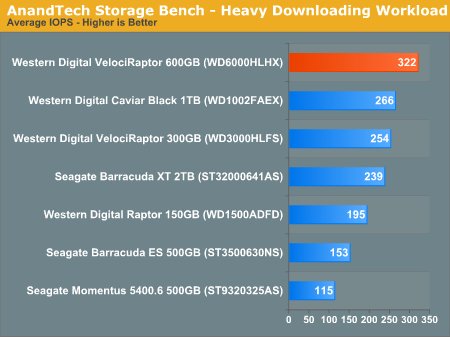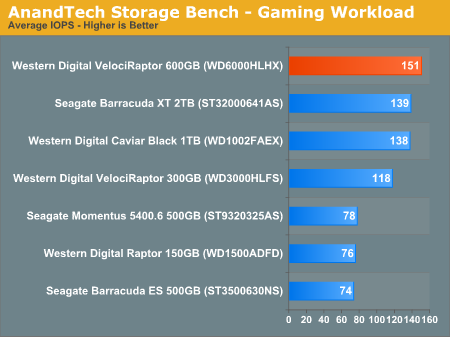Western Digital's New VelociRaptor VR200M: 10K RPM at 450GB and 600GB
by Anand Lal Shimpi on April 6, 2010 8:00 AM EST- Posted in
- Storage
AnandTech Storage Bench
The first in our benchmark suite is a light usage case. The Windows 7 system is loaded with Firefox, Office 2007 and Adobe Reader among other applications. With Firefox we browse web pages like Facebook, AnandTech, Digg and other sites. Outlook is also running and we use it to check emails, create and send a message with a PDF attachment. Adobe Reader is used to view some PDFs. Excel 2007 is used to create a spreadsheet, graphs and save the document. The same goes for Word 2007. We open and step through a presentation in PowerPoint 2007 received as an email attachment before saving it to the desktop. Finally we watch a bit of a Firefly episode in Windows Media Player 11.
There’s some level of multitasking going on here but it’s not unreasonable by any means. Generally the application tasks proceed linearly, with the exception of things like web browsing which may happen in between one of the other tasks.
The recording is played back on all of our drives here today. Remember that we’re isolating disk performance, all we’re doing is playing back every single disk access that happened in that ~5 minute period of usage. The light workload is composed of 37,501 reads and 20,268 writes. Over 30% of the IOs are 4KB, 11% are 16KB, 22% are 32KB and approximately 13% are 64KB in size. Less than 30% of the operations are absolutely sequential in nature. Average queue depth is 6.09 IOs.
The performance results are reported in average I/O Operations per Second (IOPS):

Performance in our real world benchmark however makes it very clear that no other hard drive is as fast as the 600GB VelociRaptor. WD delivers a nearly 30% improvement over the old drive, and 22% better performance than the new Caviar Black series.
If there’s a light usage case there’s bound to be a heavy one. In this test we have Microsoft Security Essentials running in the background with real time virus scanning enabled. We also perform a quick scan in the middle of the test. Firefox, Outlook, Excel, Word and Powerpoint are all used the same as they were in the light test. We add Photoshop CS4 to the mix, opening a bunch of 12MP images, editing them, then saving them as highly compressed JPGs for web publishing. Windows 7’s picture viewer is used to view a bunch of pictures on the hard drive. We use 7-zip to create and extract .7z archives. Downloading is also prominently featured in our heavy test; we download large files from the Internet during portions of the benchmark, as well as use uTorrent to grab a couple of torrents. Some of the applications in use are installed during the benchmark, Windows updates are also installed. Towards the end of the test we launch World of Warcraft, play for a few minutes, then delete the folder. This test also takes into account all of the disk accesses that happen while the OS is booting.
The benchmark is 22 minutes long and it consists of 128,895 read operations and 72,411 write operations. Roughly 44% of all IOs were sequential. Approximately 30% of all accesses were 4KB in size, 12% were 16KB in size, 14% were 32KB and 20% were 64KB. Average queue depth was 3.59.

Upping the number of writes doesn't change anything, the new VR is 26% faster than the old one and 21% faster than the best 7200 RPM drives. Keep in mind this is pure I/O performance, the real world performance is most likely in the 3 - 10% range on average which is what we saw in PCMark Vantage and SYSMark 2007.
The gaming workload is made up of 75,206 read operations and only 4,592 write operations. Only 20% of the accesses are 4KB in size, nearly 40% are 64KB and 20% are 32KB. A whopping 69% of the IOs are sequential, meaning this is predominantly a sequential read benchmark. The average queue depth is 7.76 IOs.

Sequential read performance is solid on the new VR, but not that much better than other, larger (and cheaper) drives on the market. Western Digital's advantage over the old VR is a healthy 27%, but over newer 7200 RPM drives it's barely 9%.










77 Comments
View All Comments
pjconoso - Thursday, April 8, 2010 - link
Maxtor's with Seagate, so there.ClagMaster - Tuesday, April 6, 2010 - link
These are good drives carrying on the Raptor tradition, but at the asking price at ~$0.60/Gb, way too pricy.I am going to wait next year for third generation SSD's at $0.50/Gb and 2-4x the current bandwidth before switching over.
leonsk - Tuesday, April 6, 2010 - link
Agree with Anand that SSD bor boot drive and 2 large HDs in RAID-1 is the most effective rig. What controller do you use? Or are you with software RAID?AstroGuardian - Wednesday, April 7, 2010 - link
Of course not mate. Software RAID is dead. I am sure he is using ICH10R's RAID controller.... Right Anand?bobbyto34 - Wednesday, April 7, 2010 - link
Hello,I have to change my primary hard drive (Samsung Spinpoint F1) because of some read failures...
I'm hesitating between a good ol' 1TB 7200 drive, an x-25M 160Gb or a new Velociraptor.
The computer will be used as music station with Sonar and sound banks. The current problem is that it's quite slow when loading those enormous sound banks with a 7200 drive.
I would like good performance in loading these sound banks, with silence because it's dedicated to music (and some gaming :p), and with reasonable disk space... For the moment, I can't see a good compromise with those 3 parameters. Am I wrong ?
slickr - Wednesday, April 7, 2010 - link
What the heck were you talking there buddy?You just buy 2 1TB HD and an SDD drive, to be faster. Do you know how much such configuration would put you back?
If not, go for the new raptor. Oh really, you just found out hot water. How about you mention its twice as cheap and even more to go for it, ten times more reliable than SSD's, and you can actually store 600gb, instead of 80gb of the intel ssd's or whatever for 250 dollars.
Compddd - Wednesday, April 7, 2010 - link
When will these start shipping?GullLars - Wednesday, April 7, 2010 - link
Another great test from Anand.I have a comment though, and i see i'm a day late, so i may be ignored here :(
The IOmeter sequential tests, while spanning the entire drive, only run for 3 minutes, and therefore only uses a small % of the drive area, so the speeds you see are near max.
For the 600GB velociraptor, you have 140MB/s for 3 minutes = 25GB. By looking at the HDtach curve, the drop-off has barely started by that point.
I also have something i want to get out there. Off-topic to this test, but relevant for high-performance HDDs.
Why hasn't any HDD maker yet added a flash read-cache?
By adding a single 4-8GB MLC NAND chip, costing roughly $2-3/GB = $8-24 added cost, and using it for read-caching hot-files, you can get around 4-5000 4KB random read IOPS = 16-20MB/s (@QD 1) and roughly 40-60MB/s sequential read for the cached data.
Tracking hot-files should be easy to implement simply by logging read-access to LBAs, and with a slight bit more effort, filtering LBAs being read in a small block random pattern. Possibly also caching file-table and folder/file structure and metadata, as well as the data typically read the first seconds after power-up or spin-up.
Using this type of caching would have a noticable effect on typical usage patterns, and especially multi-tasking, but would likely not make an impact on benchmarking since it would take time for new data to reach cache.
Larger hot-files could benefit from the cache as they could be read from both flash and disk at the same time with the speed of both combined (80-140 + 40-60).
Any thoughts about using flash read-cache people?
ETR - Wednesday, April 7, 2010 - link
Thats all i want to know,Does this drive have it or not???
not one reviewer anywhere has that info... nor did WD's website.
gezzzz how can anandtech skip that info................?
BoFox - Thursday, April 8, 2010 - link
Dear Anand,I'm looking to upgrade to 15000rpm SAS drives since my Foxconn Bloodrage motherboard has 2 SAS ports (it's an X58 motherboard and there are couple other from Asus and Gigabyte that include SAS ports, IIRC..).
How would this 600GB Velociraptor fare against a Seagate 15k.7 600GB Cheetah in terms of speed/performance?
Sure, a 15k drive might be a bit more noisy and power-hungry, but I'm ok with this since I have other noisy stuff (including a noisy blu-ray player). I'm thinking that having a couple 15000rpm 600GB SAS drives is still a better investment than those tiny SSD's. Over at techreport.com, it's shown that SSD's (including Intel's) have some serious performance issues with certain real-world applications and that they "degenerate" in performance whether TRIM is being used or not. Stability is another question, right?